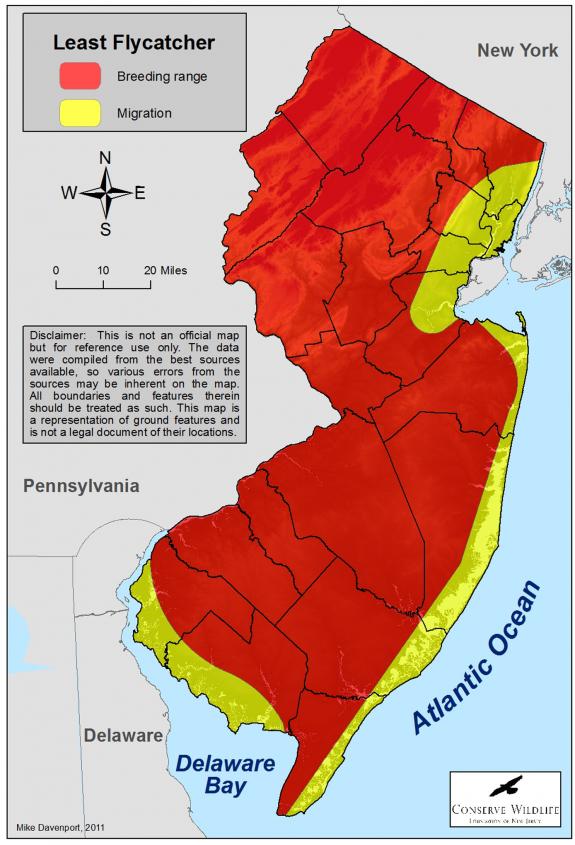Empidonax minimus
Type: bird
Status: special concern
Species Guide
Least flycatcher
Empidonax minimus
Species Type: bird
Conservation Status: special concern
IDENTIFICATION
The least flycatcher is a small migratory songbird about 5 ¼ inches in length. Like the five other closely-related flycatchers within the same genus which may be observed in New Jersey (the Acadian, alder, willow, and yellow-bellied flycatchers), it has a light eye ring and two whitish wing bars. It differs from those species in being smaller as well as grayer above and whiter below. Its sharp che-BEK call, as well as its habitat preference, also assist in identifying this species.

Distribution & Habitat
The breeding range of the least flycatcher extends from southeastern Yukon in the northwest, throughout southern Canada, to Nova Scotia east, and as far south as Wyoming, Illinois, and New Jersey. The breeding range also extends to the southwest, along the Appalachian Mountains, as far south as northern Georgia. This species winters in Mexico and Central America.
Breeding habitat includes open mature woodlands, parks, old orchards, and forest borders.
Diet
Least flycatchers primarily are insectivorous. They will feed on mosquitoes, beetles, flies, moths, caterpillars, as well as other insects which they catch by flycatching (hence their name) or by hover-gleaning from a perch under the forest canopy or fencepost or wire. They may also feed on seeds or small fruit.
Life Cycle
The breeding season for the least flycatcher in New Jersey is between early May and mid-August. Nests are built by the female and are usually located 5-20 feet above the ground in a crotch of a tree (usually deciduous) or on a tree or shrub limb. The nest is a small deep cup consisting of bark fibers, fine grasses, weed stems, and cotton. It is bound together with spider webs and cocoons and lined with grasses, hair, or feathers.
Between 3 to 6 eggs are laid in May or June and incubation by the female alone lasts about 14-16 days. The young are tended to by both parents and leave the nest 13-16 days after hatching.
Current Threats, Status, and Conservation
The least flycatcher population is stable throughout most its range. However, it is listed as a Species of Special Concern in New Jersey (not yet endangered or threatened but possibly on its way).
References
Text written by Michael J. Davenport in 2011.
Scientific Classification
- Kingdom: Animalia
- Phylum: Chordata
- Class: Aves
- Order: Passeriformes
- Family: Tyrannidae
- Genus: Empidonax
- Species: E. minimus